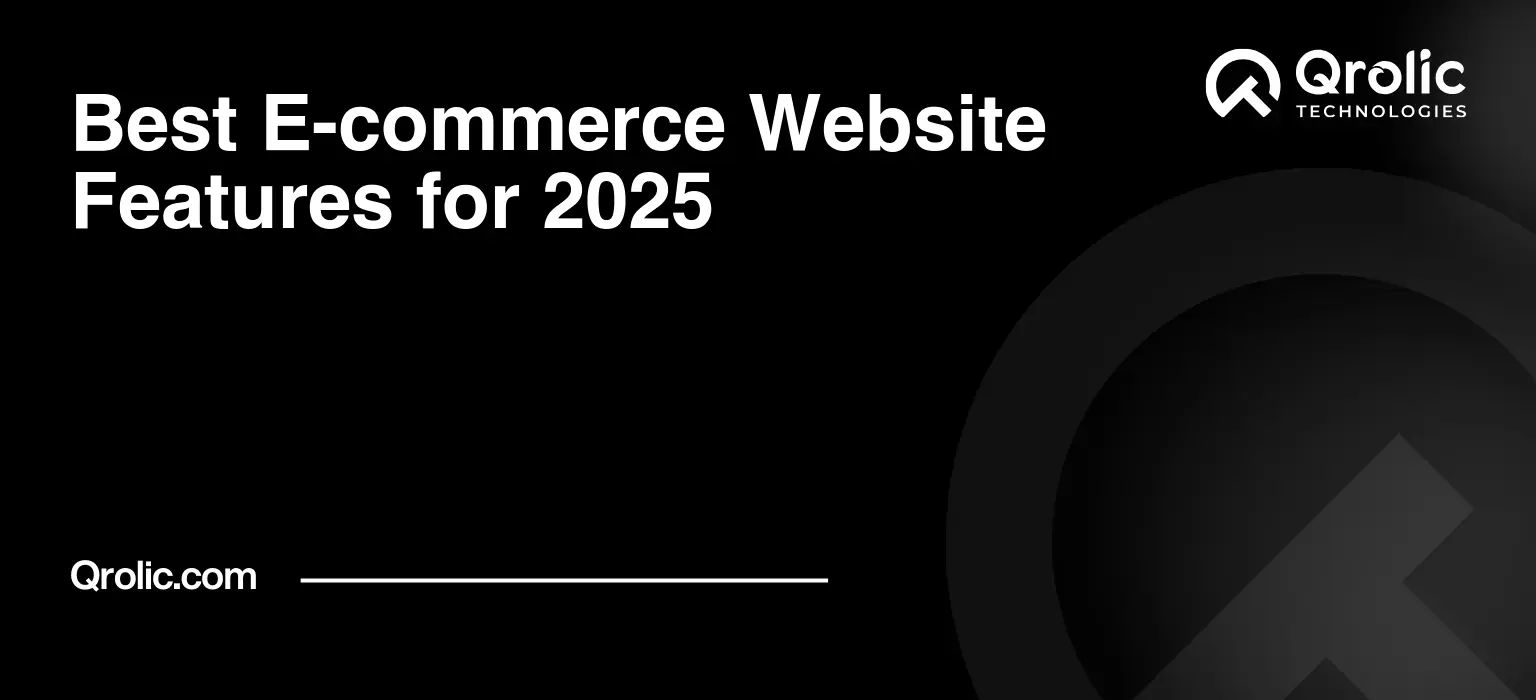Quick Summary:
- Implement AI for smart search and personalized recommendations.
- Offer seamless mobile shopping and quick guest checkout.
- Prioritize strong security and transparent practices for trust.
- Integrate immersive tech, voice, and sustainability options.
Table of Contents
- The E-commerce Landscape in 2025: A Revolution in Retail
- Core Functionality: The Foundation of E-commerce Success
- 1. Intuitive Product Discovery: Beyond Basic Search
- 1.1. AI-Powered Search & Recommendations
- 1.2. Visual Search: Shopping with Your Camera
- 1.3. Advanced Filtering & Sorting
- 2. The Seamless Shopping Cart: Conversion-Optimized for 2025
- 2.1. Persistent Shopping Cart: Never Lose Your Items
- 2.2. Guest Checkout: Speed and Convenience
- 2.3. Multiple Payment Options: Catering to Global Preferences
- 2.4. Transparent Shipping Costs and Delivery Estimates
- 2.5. Saved Payment Information: Streamlining Repeat Purchases
- 3. The Secure and Reliable Payment Gateway: Building Trust
- 3.1. PCI DSS Compliance: The Foundation of Security
- 3.2. Fraud Prevention Tools: Minimizing Risk
- 3.3. Secure Socket Layer (SSL) Certificate: Encrypting Data
- 3.4. Two-Factor Authentication (2FA): Added Security for User Accounts
- Enhanced User Experience: Going Beyond the Basics
- 4. Personalized Product Recommendations: The Art of Anticipation
- 4.1. Behavioral Targeting: Understanding User Intent
- 4.2. Personalized Content: Tailoring the Shopping Journey
- 4.3. Abandoned Cart Recovery: Re-Engaging Lost Customers
- 5. Mobile-First Design: Reaching Customers Where They Are
- 5.1. Responsive Design: Adapting to All Devices
- 5.2. Accelerated Mobile Pages (AMP): Faster Loading Times
- 5.3. Mobile App: A Dedicated Shopping Experience
- 6. Augmented Reality (AR) & Virtual Reality (VR): Immersive Shopping Experiences
- 6.1. AR Product Visualization: Seeing is Believing
- 6.2. VR Shopping Experiences: Step Inside the Store
- 7. Exceptional Customer Support: Building Relationships
- 7.1. Live Chat: Instant Assistance
- 7.2. AI-Powered Chatbots: 24/7 Support
- 7.3. Personalized Email Marketing: Targeted Communication
- 7.4. Proactive Customer Service: Anticipating Needs
- 8. Enhanced Product Pages: Driving Conversions
- 8.1. High-Quality Product Images & Videos: Showcasing Your Products
- 8.2. 360-Degree Product Views: Interactive Exploration
- 8.3. Detailed Product Descriptions: Answering All Questions
- 8.4. Customer Reviews & Ratings: Social Proof
- Emerging Trends: Preparing for the Future
- 9. Voice Commerce: Shopping with Your Voice
- 9.1. Voice Search: Find Products Hands-Free
- 9.2. Voice Ordering: Completing Purchases with Your Voice
- 10. Sustainability & Ethical Sourcing: Appealing to Conscious Consumers
- 10.1. Sustainable Product Filters: Making Conscious Choices Easier
- 10.2. Transparency in Supply Chains: Building Trust Through Information
- 11. Headless Commerce: Flexibility and Control
- 11.1. Decoupled Architecture: Freedom to Innovate
- 11.2. API-First Approach: Seamless Integrations
- Qrolic Technologies: Your Partner in Building Future-Ready E-commerce Solutions
- Conclusion: Embracing Change and Innovation
The E-commerce Landscape in 2025: A Revolution in Retail
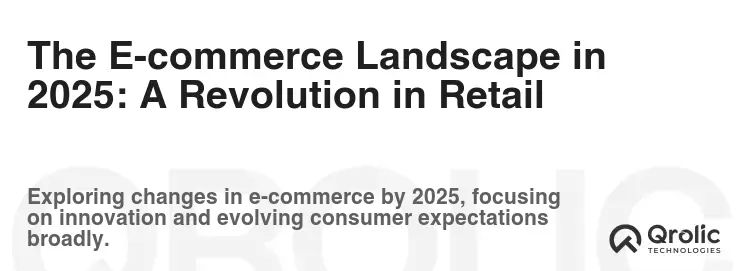
The year is 2025. The lines between physical and digital retail have blurred into near non-existence. Consumers demand a seamless, personalized, and intuitive shopping experience. Standing out in this hyper-competitive landscape requires more than just a pretty website; it demands an e-commerce platform brimming with cutting-edge features designed to convert visitors into loyal customers. Let’s dive into the essential e-commerce website features that will define success in 2025, focusing on how they address user needs and elevate the overall shopping journey.
Core Functionality: The Foundation of E-commerce Success

1. Intuitive Product Discovery: Beyond Basic Search
1.1. AI-Powered Search & Recommendations
Forget simple keyword matching. In 2025, search is powered by AI, understanding natural language, semantic nuances, and even visual cues.
- What: AI-powered search analyzes user intent behind queries, delivering more relevant results even with vague or misspelled keywords. Think of it as having a personal shopper understand exactly what you’re looking for, even if you can’t quite articulate it.
- Why: Improves product findability, reduces bounce rates, and increases conversion rates by quickly connecting customers with the items they need.
- How: Implement machine learning algorithms that analyze search history, browsing behavior, and product attributes to refine search results in real-time.
- When: Integrate AI-powered search from day one to provide a superior user experience and gather valuable data for continuous optimization.
- Example: A customer searches for “comfortable shoes for running.” The AI understands “comfortable” implies cushioning and support, and “running” implies specific shoe types and features. The search result prioritizes running shoes with high ratings for comfort and support, even if the exact words weren’t used in the product title.
1.2. Visual Search: Shopping with Your Camera
- What: Allows users to upload images of products they want to find, and the website uses image recognition to identify similar items in its catalog.
- Why: Addresses the “I saw this somewhere but don’t know what it’s called” problem. Drives sales by allowing users to find products based on inspiration images from social media or real life.
- How: Integrate image recognition APIs and train them on your product catalog to accurately identify items from user-uploaded images.
- When: Offer visual search for product categories that are visually driven, like fashion, home decor, and accessories.
- Example: A user uploads a picture of a designer handbag they saw on Instagram. The visual search engine identifies the bag and displays similar styles available on the e-commerce website.
1.3. Advanced Filtering & Sorting
- What: Go beyond basic filters like price and color. Offer granular filtering options based on materials, features, customer ratings, sustainability certifications, and more.
- Why: Allows customers to quickly narrow down their options and find exactly what they’re looking for, reducing choice paralysis and improving the overall shopping experience.
- How: Analyze customer search data and product attributes to identify the most relevant filtering options for each product category.
- When: Implement advanced filtering for product categories with a wide range of features and specifications.
- Example: A customer shopping for a laptop can filter by screen size, processor type, RAM, storage capacity, battery life, operating system, and even specific ports and features.
2. The Seamless Shopping Cart: Conversion-Optimized for 2025
2.1. Persistent Shopping Cart: Never Lose Your Items
- What: Saves items in the shopping cart even if the user closes the browser or switches devices.
- Why: Prevents frustration and abandoned carts. Allows customers to start shopping on one device and continue on another.
- How: Implement cookies or user accounts to store shopping cart data.
- When: Essential for all e-commerce websites.
- Example: A customer adds items to their cart on their phone during their commute. Later, they can access the same cart on their laptop at home.
2.2. Guest Checkout: Speed and Convenience
- What: Allows customers to purchase items without creating an account.
- Why: Removes friction and reduces cart abandonment, especially for first-time buyers.
- How: Offer a clear and prominent guest checkout option on the shopping cart page.
- When: Always offer guest checkout as an alternative to account creation.
- Example: A customer finds a product they need quickly and wants to purchase it without the hassle of creating an account.
2.3. Multiple Payment Options: Catering to Global Preferences
- What: Offer a wide range of payment methods, including credit cards, debit cards, digital wallets (Apple Pay, Google Pay, PayPal), buy now, pay later options (Klarna, Afterpay), and even cryptocurrency.
- Why: Caters to different customer preferences and expands your market reach.
- How: Integrate with multiple payment gateways to offer a variety of options.
- When: Continuously evaluate and update payment options based on customer demand and emerging trends.
- Example: A customer in Europe prefers to pay with a local digital wallet, while a customer in the US prefers to use a buy now, pay later option.
2.4. Transparent Shipping Costs and Delivery Estimates
- What: Display accurate shipping costs and delivery estimates upfront, before the customer reaches the checkout page.
- Why: Builds trust and prevents unexpected costs from leading to cart abandonment.
- How: Integrate with shipping carriers to get real-time shipping rates and delivery estimates based on the customer’s location and the weight and dimensions of the items in their cart.
- When: Display shipping costs and delivery estimates on the product page and in the shopping cart.
- Example: A customer adds an item to their cart and sees the shipping cost and estimated delivery date displayed prominently.
2.5. Saved Payment Information: Streamlining Repeat Purchases
- What: Allows customers to securely save their payment information for faster checkout on future purchases.
- Why: Improves the customer experience and encourages repeat business.
- How: Implement secure tokenization and PCI DSS compliance to protect customer payment data.
- When: Offer saved payment information as an option for registered users.
- Example: A customer can choose to save their credit card information during checkout and then use it for future purchases with a single click.
3. The Secure and Reliable Payment Gateway: Building Trust
3.1. PCI DSS Compliance: The Foundation of Security
- What: Adherence to the Payment Card Industry Data Security Standard, a set of security standards designed to protect cardholder data.
- Why: Builds trust with customers and protects their sensitive financial information. Essential for processing credit card payments.
- How: Partner with a PCI DSS compliant payment gateway and implement secure coding practices.
- When: Continuous compliance is required for all e-commerce websites that process credit card payments.
- Example: Regularly audit your systems and processes to ensure compliance with the latest PCI DSS standards.
3.2. Fraud Prevention Tools: Minimizing Risk
- What: Implement tools and strategies to detect and prevent fraudulent transactions.
- Why: Protects your business from financial losses and chargebacks. Builds trust with legitimate customers.
- How: Use address verification systems (AVS), card verification values (CVV), and machine learning algorithms to identify suspicious transactions.
- When: Implement fraud prevention tools from day one and continuously monitor transactions for suspicious activity.
- Example: A transaction from a new customer with a different billing and shipping address is flagged as potentially fraudulent.
3.3. Secure Socket Layer (SSL) Certificate: Encrypting Data
- What: An SSL certificate encrypts the data transmitted between the customer’s browser and the e-commerce website, protecting sensitive information from interception.
- Why: Builds trust with customers and protects their personal and financial information.
- How: Obtain an SSL certificate from a trusted certificate authority and install it on your web server.
- When: Essential for all e-commerce websites.
- Example: Ensure that your website URL starts with “https” and displays a padlock icon in the browser address bar.
3.4. Two-Factor Authentication (2FA): Added Security for User Accounts
- What: Requires users to provide two forms of authentication when logging into their accounts, such as a password and a code sent to their phone.
- Why: Protects customer accounts from unauthorized access.
- How: Implement a 2FA system that supports multiple authentication methods, such as SMS codes, authenticator apps, and biometric authentication.
- When: Offer 2FA as an option for all registered users.
- Example: A customer logs into their account and is prompted to enter a code sent to their phone to verify their identity.
Enhanced User Experience: Going Beyond the Basics
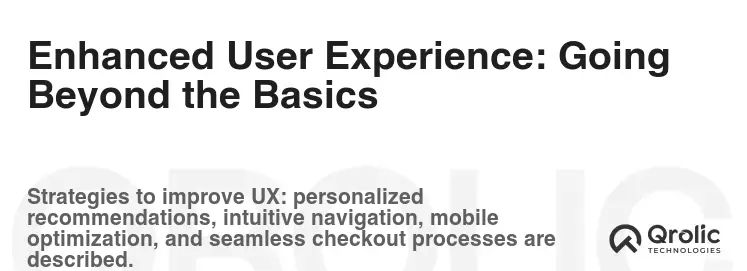
4. Personalized Product Recommendations: The Art of Anticipation
4.1. Behavioral Targeting: Understanding User Intent
- What: Uses data on user browsing history, purchase history, and demographics to personalize product recommendations.
- Why: Increases sales by showing customers products they are more likely to be interested in. Improves the overall shopping experience.
- How: Implement machine learning algorithms that analyze user behavior and predict their preferences.
- When: Continuously analyze user data and refine your recommendation algorithms.
- Example: A customer who recently purchased a running shirt is shown recommendations for running shorts and shoes.
4.2. Personalized Content: Tailoring the Shopping Journey
- What: Customizes the content on the website based on user preferences, location, and past behavior.
- Why: Creates a more engaging and relevant shopping experience. Increases conversion rates and customer loyalty.
- How: Use data to personalize product listings, banners, and even the overall website layout.
- When: Continuously test and optimize personalized content to maximize its effectiveness.
- Example: A customer in a cold climate is shown recommendations for winter clothing, while a customer in a warm climate is shown recommendations for summer clothing.
4.3. Abandoned Cart Recovery: Re-Engaging Lost Customers
- What: Sends automated emails to customers who have added items to their cart but haven’t completed the purchase.
- Why: Recovers lost sales and reminds customers of items they may have forgotten.
- How: Implement an abandoned cart recovery system that sends personalized emails with images of the items in the cart and a link to complete the purchase.
- When: Send abandoned cart emails within 24 hours of the customer leaving the website.
- Example: An email is sent to a customer who added a pair of shoes to their cart but didn’t complete the purchase, reminding them of the shoes and offering a discount to encourage them to buy.
5. Mobile-First Design: Reaching Customers Where They Are
5.1. Responsive Design: Adapting to All Devices
- What: Ensures that the website looks and functions perfectly on all devices, from smartphones to tablets to desktop computers.
- Why: Provides a consistent and enjoyable shopping experience regardless of the device being used.
- How: Use a responsive design framework that adapts the website layout and content to different screen sizes.
- When: Essential for all e-commerce websites.
- Example: The website automatically adjusts its layout and content to fit the screen size of a smartphone, making it easy to browse products and complete purchases.
5.2. Accelerated Mobile Pages (AMP): Faster Loading Times
- What: Uses AMP technology to create lightweight versions of web pages that load quickly on mobile devices.
- Why: Improves the mobile shopping experience and reduces bounce rates.
- How: Implement AMP on your product pages and blog posts.
- When: Prioritize AMP for pages that are frequently accessed on mobile devices.
- Example: A product page built with AMP loads almost instantly on a smartphone, providing a seamless shopping experience.
5.3. Mobile App: A Dedicated Shopping Experience
- What: A dedicated mobile app that provides a more immersive and personalized shopping experience.
- Why: Increases customer engagement and loyalty. Allows for push notifications and other mobile-specific features.
- How: Develop a mobile app for iOS and Android devices.
- When: Consider developing a mobile app if you have a large and loyal customer base.
- Example: A customer can use the mobile app to browse products, make purchases, track orders, and receive personalized recommendations.
6. Augmented Reality (AR) & Virtual Reality (VR): Immersive Shopping Experiences
6.1. AR Product Visualization: Seeing is Believing
- What: Allows customers to visualize products in their own homes or on themselves using augmented reality.
- Why: Increases confidence in purchasing decisions and reduces returns.
- How: Integrate AR technology into your mobile app or website.
- When: Offer AR product visualization for product categories where it is particularly helpful, such as furniture, clothing, and cosmetics.
- Example: A customer can use their smartphone to see how a new sofa would look in their living room before buying it.
6.2. VR Shopping Experiences: Step Inside the Store
- What: Creates immersive virtual reality shopping experiences that allow customers to browse products and interact with them in a virtual environment.
- Why: Provides a unique and engaging shopping experience. Can be used to showcase products in a more realistic and interactive way.
- How: Develop VR shopping experiences for compatible VR headsets.
- When: Consider VR shopping experiences for product categories where they can provide a significant added value, such as luxury goods and home decor.
- Example: A customer can use a VR headset to walk through a virtual showroom and browse furniture and accessories.
7. Exceptional Customer Support: Building Relationships
7.1. Live Chat: Instant Assistance
- What: Provides real-time customer support through a chat window on the website.
- Why: Improves customer satisfaction and increases sales by providing instant answers to questions.
- How: Integrate a live chat platform into your website and train your customer support team to use it effectively.
- When: Offer live chat support during business hours.
- Example: A customer has a question about a product and can get an immediate answer from a live chat agent.
7.2. AI-Powered Chatbots: 24/7 Support
- What: Uses AI to answer common customer questions and provide basic support.
- Why: Provides 24/7 customer support and frees up human agents to handle more complex issues.
- How: Train an AI-powered chatbot on your product information and customer support knowledge base.
- When: Use AI-powered chatbots to handle common customer inquiries and escalate more complex issues to human agents.
- Example: A customer can ask the chatbot about shipping costs and delivery times and get an immediate answer.
7.3. Personalized Email Marketing: Targeted Communication
- What: Sends targeted email campaigns based on customer preferences, purchase history, and browsing behavior.
- Why: Increases sales and customer loyalty by providing relevant information and offers.
- How: Use a marketing automation platform to segment your customer base and send personalized email campaigns.
- When: Continuously analyze customer data and refine your email marketing strategy.
- Example: A customer who recently purchased a camera is sent an email with information about related accessories and photography tips.
7.4. Proactive Customer Service: Anticipating Needs
- What: Reaching out to customers proactively to offer assistance or address potential issues.
- Why: Demonstrates a commitment to customer satisfaction and builds loyalty.
- How: Monitor customer orders and proactively reach out to customers if there are any delays or issues.
- When: Implement proactive customer service for high-value customers or for orders with potential issues.
- Example: A customer who placed a large order is contacted by a customer service representative to confirm the order and offer assistance.
8. Enhanced Product Pages: Driving Conversions
8.1. High-Quality Product Images & Videos: Showcasing Your Products
- What: Use high-quality images and videos to showcase your products from multiple angles.
- Why: Increases customer confidence and reduces returns.
- How: Invest in professional photography and videography.
- When: Essential for all product pages.
- Example: A product page features multiple high-resolution images of the product, as well as a video demonstrating its features and benefits.
8.2. 360-Degree Product Views: Interactive Exploration
- What: Allows customers to rotate and zoom in on products to view them from all angles.
- Why: Provides a more immersive and interactive shopping experience.
- How: Use 360-degree photography equipment to capture images of your products.
- When: Offer 360-degree product views for product categories where they are particularly helpful, such as furniture, clothing, and electronics.
- Example: A customer can rotate a 3D model of a shoe to see it from all angles.
8.3. Detailed Product Descriptions: Answering All Questions
- What: Provide detailed and accurate product descriptions that answer all potential customer questions.
- Why: Reduces customer confusion and increases sales.
- How: Research your products thoroughly and write clear and concise descriptions that highlight their key features and benefits.
- When: Essential for all product pages.
- Example: A product description includes information about the product’s dimensions, materials, features, warranty, and care instructions.
8.4. Customer Reviews & Ratings: Social Proof
- What: Display customer reviews and ratings on product pages.
- Why: Builds trust and provides social proof.
- How: Integrate a review and rating system into your website and encourage customers to leave reviews.
- When: Essential for all product pages.
- Example: A product page features customer reviews that highlight the product’s quality, features, and benefits.
Emerging Trends: Preparing for the Future
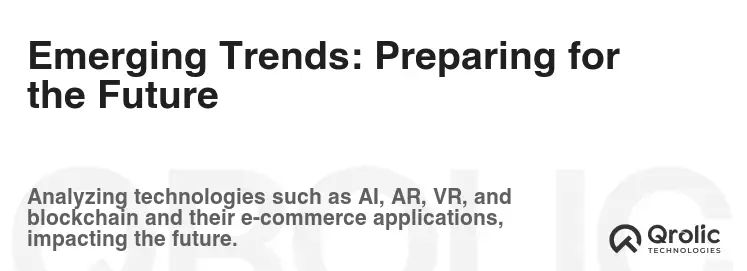
9. Voice Commerce: Shopping with Your Voice
9.1. Voice Search: Find Products Hands-Free
- What: Allows customers to search for products using voice commands.
- Why: Provides a convenient and hands-free shopping experience.
- How: Integrate voice search functionality into your website or mobile app.
- When: Optimize your product pages for voice search by using natural language and long-tail keywords.
- Example: A customer can say “Hey Alexa, find me a blue shirt” and the website will display search results for blue shirts.
9.2. Voice Ordering: Completing Purchases with Your Voice
- What: Allows customers to complete purchases using voice commands.
- Why: Provides a seamless and convenient shopping experience.
- How: Integrate voice ordering functionality into your website or mobile app.
- When: Offer voice ordering for frequently purchased items or for items that are easy to describe.
- Example: A customer can say “Hey Google, order me two bottles of water” and the website will complete the purchase.
10. Sustainability & Ethical Sourcing: Appealing to Conscious Consumers
10.1. Sustainable Product Filters: Making Conscious Choices Easier
- What: Allows customers to filter products based on sustainability certifications, materials, and ethical sourcing practices.
- Why: Appeals to environmentally conscious consumers.
- How: Add sustainable product filters to your website and clearly label products with sustainability certifications.
- When: Offer sustainable product filters for product categories where they are relevant, such as clothing, food, and home goods.
- Example: A customer can filter products to only show items made from organic cotton or recycled materials.
10.2. Transparency in Supply Chains: Building Trust Through Information
- What: Provides information about the origin and production of products.
- Why: Builds trust with customers and demonstrates a commitment to ethical sourcing.
- How: Use blockchain technology or other methods to track the origin and production of your products.
- When: Provide transparency in supply chains for products where it is particularly important, such as coffee, chocolate, and clothing.
- Example: A customer can scan a QR code on a product to learn about its origin, production process, and the workers involved.
11. Headless Commerce: Flexibility and Control
11.1. Decoupled Architecture: Freedom to Innovate
- What: Separates the front-end presentation layer of the e-commerce website from the back-end commerce engine.
- Why: Provides greater flexibility and control over the customer experience.
- How: Use a headless commerce platform that allows you to build custom front-end experiences using your preferred technologies.
- When: Consider headless commerce if you need to create highly customized shopping experiences or if you want to integrate your e-commerce platform with other systems.
- Example: A retailer uses a headless commerce platform to create a custom mobile app with a unique shopping experience that is separate from the main e-commerce website.
11.2. API-First Approach: Seamless Integrations
- What: Uses APIs to connect the front-end and back-end of the e-commerce website.
- Why: Allows for seamless integrations with other systems and services.
- How: Choose a headless commerce platform with a robust API that allows you to connect to other systems.
- When: Essential for headless commerce.
- Example: A retailer uses APIs to connect their headless commerce platform to their CRM, marketing automation system, and inventory management system.
Qrolic Technologies: Your Partner in Building Future-Ready E-commerce Solutions

In the rapidly evolving world of e-commerce, staying ahead of the curve is essential for success. Qrolic Technologies (https://qrolic.com/) is your trusted partner in building future-ready e-commerce solutions that incorporate the latest technologies and features. We specialize in creating custom e-commerce platforms that are tailored to your specific business needs and designed to deliver exceptional customer experiences.
How Qrolic Technologies Can Help You:
- Custom E-commerce Development: We build custom e-commerce platforms from the ground up, incorporating the latest features and technologies to meet your specific needs.
- Headless Commerce Solutions: We help you implement headless commerce solutions that provide greater flexibility and control over the customer experience.
- Mobile App Development: We develop custom mobile apps for iOS and Android devices that provide a seamless and engaging shopping experience.
- AI Integration: We integrate AI-powered features into your e-commerce platform, such as personalized product recommendations, AI-powered search, and chatbots.
- Payment Gateway Integration: We integrate with a wide range of payment gateways to offer your customers a variety of payment options.
- Ongoing Support & Maintenance: We provide ongoing support and maintenance to ensure that your e-commerce platform is always up-to-date and running smoothly.
Why Choose Qrolic Technologies?
- Experienced Team: Our team of experienced developers, designers, and marketers has a proven track record of building successful e-commerce solutions.
- Custom Solutions: We build custom solutions that are tailored to your specific business needs.
- Cutting-Edge Technology: We use the latest technologies and frameworks to build future-ready e-commerce platforms.
- Client-Centric Approach: We are committed to providing exceptional customer service and building long-term relationships with our clients.
Partner with Qrolic Technologies and transform your e-commerce business for the future. Visit our website at https://qrolic.com/ to learn more.
Conclusion: Embracing Change and Innovation
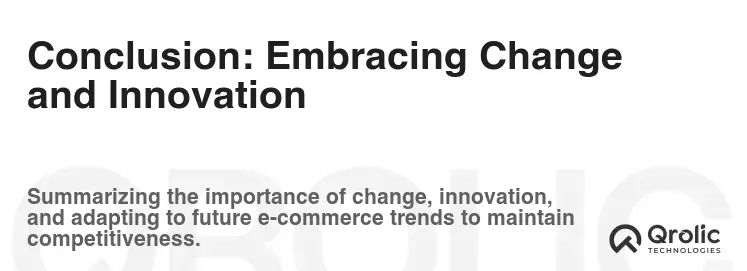
The e-commerce landscape in 2025 will be defined by personalization, seamless experiences, and emerging technologies. By embracing the features outlined in this article, you can position your business for success and create a thriving online presence that meets the evolving needs of your customers. The key is to continuously adapt, innovate, and prioritize the customer experience above all else. By doing so, you can create a loyal customer base and achieve sustainable growth in the years to come.
